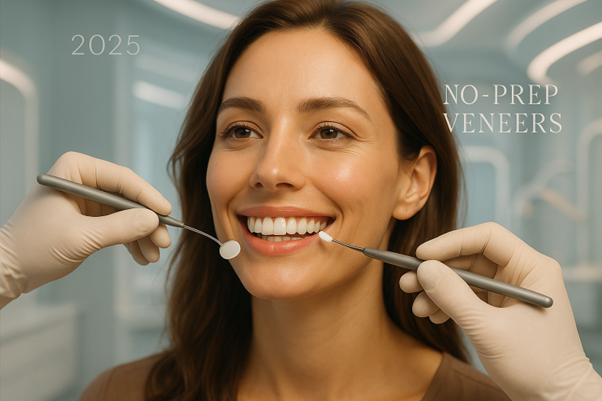Veneers have long been a cornerstone in cosmetic dentistry, offering a reliable way to mask imperfections, close gaps, and achieve a more aesthetically pleasing smile. Over time, advancements in materials and techniques have made veneers more sophisticated—and now, innovation is leading the charge: no‑prep veneers. These ultra-thin, pain-free veneers require little to no enamel removal—perfect for patients seeking a refined smile with minimal intervention. These non‑invasive cosmetic dentistry options are reshaping smile makeover trends.
And now, No‑Prep Veneers in 2025 are making waves—offering faster, safer, and more aesthetic outcomes than ever before. “Our advances allow patients to achieve stunning smiles without sacrificing enamel,” says Dr. Jaydev M, underscoring how minimal prep veneers are defining the next generation of cosmetic veneers 2025.
Dr. Jaydev M is a UK-trained cosmetic dentist in Hyderabad with a rich portfolio of over 2,000 smile makeovers. His premium dental clinic in Jubilee Hills is globally known for delivering high-end treatments that cater especially to NRIs and international patients. With a focus on minimally invasive techniques, Dr. Jaydev offers advanced care in No-Prep Veneers in 2025, setting benchmarks in aesthetic and functional excellence.
What Are No-Prep Veneers and Why Are They Trending in 2025?
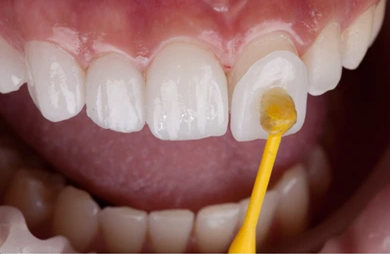
No‑prep veneers or ultra‑thin veneers are wafer-thin porcelain or composite laminates bonded to the front teeth. Unlike traditional veneers, they require little to no enamel removal—making them virtually a pain‑free veneers option.
In 2025, there’s a surge in demand due to improved materials and digital workflows. Patients in Hyderabad and beyond prefer non‑invasive cosmetic dentistry solutions that blend function, comfort, and aesthetics seamlessly.
How Do No-Prep Veneers Differ from Traditional Veneers?

- Enamel Conservation:
- No-prep: Little to no enamel removal—ideal for preserving natural tooth structure.
- Traditional: Typically, 0.5–0.7 mm enamel is removed to accommodate veneer thickness.
- Thickness & Appearance:
- No-prep: Ultra-thin veneers (0.2–0.3 mm), delivering a natural, translucent look.
- Traditional: Thicker veneers that may occasionally appear bulky.
- Procedure Complexity:
- No-prep: Often, one to two visits with minimal adjustment.
- Traditional: Requires preparatory work and possibly temporary restorations.
- Reversibility & Tooth Integrity:
- No-prep: Potentially reversible since enamel is intact, though not always advised.
- Traditional: Irreversible due to enamel removal.
Dr. Jaydev M adds, “Minimal prep veneers preserve enamel and boost long‑term oral health while delivering exceptional cosmetic outcomes.” His approach ensures patients enjoy durable, aesthetic results without compromising structure.
Benefits of No-Prep Veneers: Why Patients Love Them
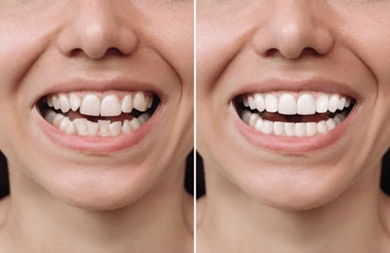
- Non‑Invasive Treatment:
Enamel integrity is maintained, making it a pain‑free veneers experience.
- Time‑Efficient:
Many Smile Makeover 2025 cases completed in just one or two visits.
- Reversible Potential:
With no enamel removal, you may reverse the veneer treatment if desired.
- Natural Aesthetics:
Ultra-thin porcelain mimics the translucency and light reflection of natural teeth, providing a seamless appearance.
- Reduced Sensitivity:
Preserving enamel lowers post-treatment sensitivity issues.
- Minimal Gum Impact:
With less tooth reduction, there’s a lower risk of gum recession.
- Lower Anxiety:
The swift, non-invasive nature of the procedure means reduced dental anxiety for patients.
The Latest Innovations in No-Prep Veneer Technology (2025 Update)
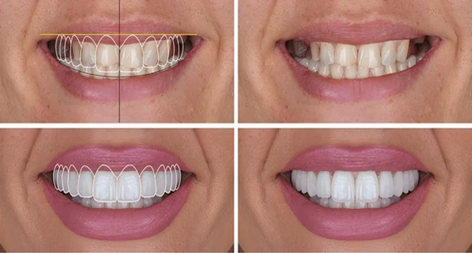
- Advanced Digital Smiles:
AI-driven design software improves precision, offering a virtual preview before placement.
- Next-Gen Ceramics:
New porcelain blends offer superior strength (up to 400 MPa) while maintaining ultra-thin profiles.
- Smart Adhesives:
Bioactive bonding agents enhance bonding strength and release minerals to support enamel health.
- Temporary Setup:
3D-printed prototypes for patient trial—ensuring satisfaction before final placement.
- Nanocoatings:
Hydrophobic and antimicrobial surface treatments improve stain resistance and oral hygiene.
The No-Prep Veneer Procedure: What to Expect

- Initial Consultation & Smile Design:
This begins with a comprehensive evaluation, digital scans, and a smile simulation to align with your facial features and aesthetic goals. It ensures the result is customized, precise, and natural-looking.
- Preparation:
In most cases, there’s no need to drill or remove enamel, preserving your natural tooth structure. This step keeps the process pain-free and anxiety-free.
- Digital Impressions:
Instead of traditional molds, advanced intraoral scanners are used to capture high-resolution images of your teeth. This ensures perfect-fitting veneers with enhanced comfort.
- Trial Bonding (optional):
Temporary 3D-printed veneers may be applied to preview your new smile before final placement. This allows you to provide feedback and request tweaks.
- Final Veneer Fabrication:
Using high-strength ceramics, your permanent veneers are custom-milled to perfection. Each piece is designed to match your natural teeth in shade and shape.
- Bonding & Final Placement:
A professional employs advanced adhesives to bond the veneers firmly and precisely. Any final fitting adjustments are executed to provide balance and bite harmony.
- Finishing Touches:
Once in position, veneers are polished, and the margins are examined to ensure a natural, seamless appearance. Your smile is perfected to the desired state.
- Aftercare Plan:
You’ll be given detailed instructions for maintaining oral hygiene and protecting your veneers in the long term. This helps your smile makeover remain healthy and radiant for years to come.
Maintaining Your No-Prep Veneers for Long-Lasting Results
- Oral Hygiene: Brush twice daily with non-abrasive toothpaste and floss everyday.
- Night Guards: Wear a custom night guard if you grind teeth.
- Avoid Abrasives: Skip whitening strips or baking soda—could damage veneers.
- Diet Awareness: Limit staining drinks like coffee, tea, and red wine.
- Regular Checkups: Bi-annual visits help to monitor veneers and overall oral health.
- Touch-Up Care: Minor polishing during visits keeps veneers looking fresh and glossy.
Is 2025 the Year to Choose No-Prep Veneers for Your Smile?
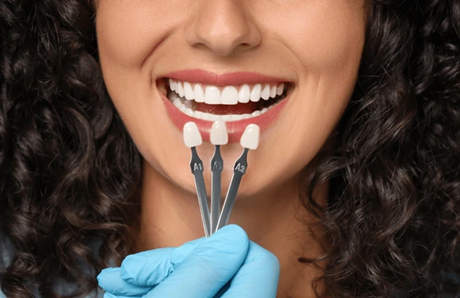
If you’re aiming for a transformative smile without drilling, discomfort, or downtime, 2025 is shaping up to be the ideal year to embrace no-prep veneers. Thanks to advancements in ultra-thin ceramics, smart adhesives, and digital design, patients now enjoy fast, safe, and natural-looking results with minimal impact on their original teeth. This shift toward non-invasive cosmetic dentistry reflects a growing demand for procedures that offer both aesthetic enhancement and oral health preservation.
Moreover, no-prep veneers cater perfectly to modern lifestyles—especially for NRIs and international patients seeking efficient, high-quality treatments during their visits to India. With remote consultation capabilities and same-trip smile makeovers, these veneers offer a level of convenience and excellence that’s hard to match. The combination of technology, patient comfort, and premium aesthetic outcomes makes 2025 the most promising time yet for this smile upgrade.
Comparing Costs: No-Prep Veneers vs Traditional Veneers
| Feature | No-Prep Veneers |
Traditional Veneers
|
| Veneer Material Cost |
Moderate–high
|
High |
| Chair Time & Appointments |
1–2 visits
|
2–3 visits
|
| Preparation Complexity | Minimal |
Extensive enamel removal
|
| Ancillary Procedures |
Often none
|
Temporaries, sedation
|
| Long-term Maintenance |
Same as conventional
|
Same
|
| Cost Range per tooth (India) |
₹25,000–₹40,000
|
₹30,000–₹50,000
|
Though no‑prep veneers can have similar or slightly lower initial expenses because of fewer visits, your ultimate investment is based on lab quality, materials, and dentist’s skill. Financing options are available at Dr. Jaydev’s clinic for NRI and overseas patients to make non-invasive smile makeovers accessible.
Get Every Single Answer About The Treatment
What are no‑prep veneers, and how do they work?
Are no‑prep veneers better than traditional veneers?
How long do no‑prep veneers last?
Are no‑prep veneers painful to get?
Can no‑prep veneers be removed later?
Who is a good candidate for no‑prep veneers?
Reference links:
https://www.businessinsider.com/no-prep-veneers-new-trend-in-cosmetic-dentistry-2025-4
https://aacd.com/exquisite-esthetics-with-no-preparation-veneers
Disclaimer: The information shared in this content is for educational purposes and not for promotional use.
